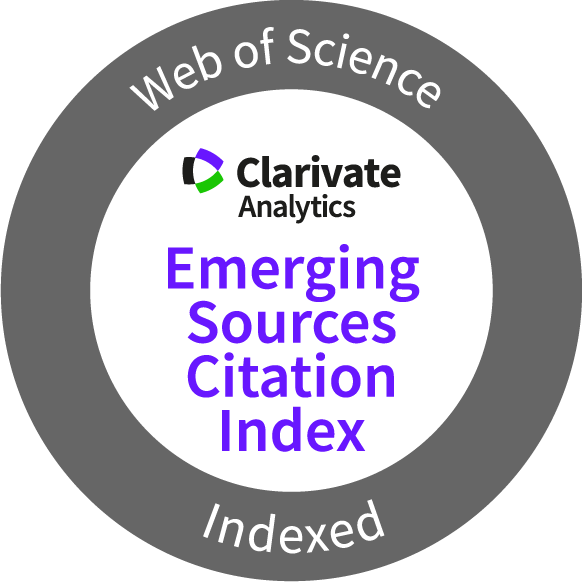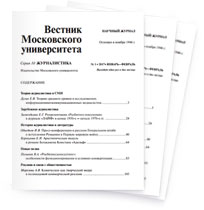Issue
№ 1
' 2025
Content:
-
Media Economics
«Integral indicator of the media communication industry: a tool to analyze a new socio-economic category»
The paper presents a methodological framework for developing a quantitative analytical tool for a new socio-economic category – the media communication industry (MCI). The proposed tool, the integral indicator of the MCI, enables the assessment of the industry’s development level across various aspects and manifestations based on statistical data from national media communication industry databases. The methodology for calculating integral indicators follows an econometric approach and builds upon theoretical foundations and contributions from Russian and international scholars (including the authors) employing the principal component method to reduce the dimensionality of socio-economic indicator sets. The construction of the indicator incorporates empirical data spanning a ten-year period across the constituent entities of the Russian Federation. As a result, the developed research tool provides an accurate representation of the media communication industry’s qualitative state at both national and regional levels. Importantly, it is mathematically robust and preserves essential variability. The study establishes key principles for classifying the country’s regions based on the level of development and operational characteristics of the media communication industry, as well as its contribution to the regional economy. Furthermore, it formulates the main parameters of a mathematical model linking regional media communication industry development levels with broader macroeconomic indicators.
Keywords: media; media communication industry; integral indicator; principal component method; regional ranking; Mediamonitor
DOI: 10.55959/ msu.vestnik.journ.1.2025.332Sergei A. Vartanov, Yulia S. Nefedova, Sergey I. Nefedov 3 -
New Media
«New media in the city system of creation and distribution of news content»
During the last decade new media have adopted some of the functionalities of the traditional media and have become an integral part of the city-based media systems. This development has led to their increasing involvement in the news distribution system. There are three approaches to the study of new media at the Russian academic discourse: political activism and the theory of cumulative deliberation; analysis of individual cases of new media and generalization of material from several regions (cities) and definition of typology, genres and models of individual city’s publics and channels; an in-depth analysis of the relationship between traditional and new media and the place of the latter in the media system. Our approach involves studying the development of news (or journalistic) discourse at the city level of the Russian media system (on the example of one city – Sochi). The results were obtained on the data collected during content analysis of 1644 posts in the social network VKontakte and at the messenger Telegram (publications have been taken for one week 05.12.2022 – 11.12.2022). The authors of this study have been searching answers to the questions: What characteristics do original Sochi’s new media have and how do they function as a system? Which approaches to distributing news content do they use? On what basis is it possible to typologize these news sources? The results showed that despite the numerical superiority of noninstitutionalized new media over traditional media, at the moment the former are not currently forming a full-fledged news environment as a separate self-sufficient segment of the urban media system. The authors claimed that it is possible to distinguish and describe at least five different types of original new media due to their maim characteristics: “classic editions” – public pages / channels of traditional media / media companies and official bodies – are not very popular, but quite active in producing original content; “dezhurnaya chast” – niche thematic resources (most often in the “emergency” format) – in demand among the audience, partly producing visible share of own original content; “journalists from digital platforms” – media with a conventionally “journalistic” slant – are small in number, produce content by themselves quite actively, use more “journalistic” techniques and initiate single socially significant topics; “leaders-aggregators” – the most popular resources among the audience – post the largest volumes of advertising and content (primarily borrowed); “little aggregators” (“repeaters”) – numerous smaller “clones” of media of the previous type, most often even more secondary. The main functionality of the resources under the study is seen primarily in increasing the coverage of legacy media’s news materials, rather than in their production. They are, in essence, a (non-institutionalized) “filtering system” that does not have uniform and clear rules for selection and editing, through which information collected and “packaged” by other actors of the urban media system is dissiminated.
Keywords: hyperlocal new media, non-institutionalized media, typology of new media, city news media system, VKontakte publics, Telegram channels
DOI: 10.55959/msu.vestnik.journ.1.2025.3368Anna O. Kanaylova, Mikhail I. Makeenko 33 -
Sociology of Journalism
«News avoidance in Russia: Scope and characteristics»
This article explores the phenomenon of news avoidance in Russia during 2023–2024, drawing on data from a survey of 6,007 respondents and 67 interviews. The study reveals that over 20% of Russians consciously limit their news consumption, indicating that a significant portion of the population engages in news avoidance, although it is less widespread than in many other countries. The most commonly avoided topics include politics, international relations, crime, and economics. The primary reasons for avoiding news are its negative impact on mood, an oversaturation of political content, news fatigue, and distrust in the media. Women are more likely than men to cite emotional reasons for avoiding news, which may be linked to gender stereotypes and differences in socialization. News avoidance strategies vary, with the most common approaches including reducing the number of news sources, limiting time spent on news, or redirecting attention to alternative activities. News consumption regulation predominantly occurs through self-restriction and conscious habit adjustment rather than changing of the information environment. Although news avoidance is often aimed at preserving mental health, individuals who limit their news intake tend to experience higher levels of emotional distress.
Keywords: news consumption, media consumption, news avoidance, trust in news
DOI: 10.55959/msu.vestnik.journ.1.2025.6993Anastasia D. Kazun 69 -
History of Journalism
«Periodization of the economic development of the Soviet press in the 1920s»
This study addresses the issue of periodization of the economic development of the Soviet press in the 1920s. It is traditionally argued that the New Economic Policy marked a distinct stage in the development of the Soviet press, characterized by greater political freedom and liberal economic policy. Based on the analysis of archival documents, the author argues that the economic development of the Soviet press in the 1920s was complex and the established chronology does not fully capture its dynamics. The author identifies three main stages of the economic development of the Soviet mass media in the 1920s, which do not completely coincide with the NEP period. The first stage began in December 1921 with the liberalization of the printing market. It lasted until late 1922 and was marked by a severe crisis in the press industry. It was replaced by a period of rapid yet chaotic development that lasted until mid-1925. During this period, the Soviet press showed a significant increase in production and financial indicators, which, however, turned out to be constrained by limited resources and did not meet the political objectives of the Soviet government. Thus, in the second half of 1925, the third stage commenced – the transition to a planned economy, which continued until the early 1930s.
Keywords: 1920th, periodization of press development, press, NEP, media economics
DOI: 10.55959/msu.vestnik.journ.1.2025.94129Maksim I. Babyuk 94 -
«Axiological portrait of Russian hunters in the genre of obituary (based on the material of nature and hunting magazines)»
For the first time, this article examines obituaries and other memorial essays (written for anniversaries of death and commemorative days) as a form of commemorative text aimed at preserving significant fragments of the past within the hunter community. The study is based on pre-revolutionary nature and hunting magazines, focusing on hunters-researchers, dog breeders, writers, and editorpublishers who faithfully served the Russian Diana, contributing to the development of hunting, specialized printing, and hunting literature. The analysis of the formal and substantive components of obituaries revealed the spiritual and moral principles on which members of the hunting community built their lives and careers — principles of unity, trust, camaraderie, brotherhood, and family cohesion. These values remain relevant for shaping future generations of hunters. The study aims to explore the obituary genre as a commemorative text that reinforces the values and behaviors significant to the hunter community within national memory. The axiological portrait of the Russian hunter is reconstructed based on biographical facts and information about their contributions to hunting development. The examination of obituaries published in pre-revolutionary nature and hunting journals through the lens of “perpetuation” theory demonstrates their alignment with a broader commemorative strategy—preserving names and deeds in the memory of future generations.
Keywords: genre of obituary, nature and hunting magazines, cultural memory
DOI: 10.55959/msu.vestnik.journ.1.2025.130148Alina V. Lyapina 130 -
«Pisarev’s debut year and his role in shaping a new magazine model «for girls»»
This article examines the journalistic activity of D. I. Pisarev during his debut year — from his initial review of an essay about N. B. Dolgorukova for Rassvet (Daybreak), organized by V. A. Krempin in October 1858, until the termination of their collaboration due to Pisarev’s illness in November 1859. The work of the young debutant is analyzed in the context of the formation of a new model of a monthly magazine “for grown-up girl”. The study identifies Pisarev’s key creative principles as the leader of the magazine’s bibliographic section, emphasizing his engagement with both female readers and their mentors to promote the intellectual, moral, and civic development of young women in pre-reform Russia. It is concluded that Pisarev’s contributions largely defined the identity of Rassvet (Daybreak), shaping it into a literary and publicistic multifunctional magazine “for grown-up girls” that demonstrated moderate liberal tendencies and balanced factual reporting with socio-political themes, the women’s question, and educational content from various fields of knowledge.
Keywords: D. I. Pisarev, debut year, publicistic bibliography, Rassvet (Daybreak), magazine model «for grown-up girls
DOI: 10.55959/msu.vestnik.journ.1.2025.149167Irina E. Prokhorova 149 -
«The Soyuzphoto/TASS central photography courses (1936–1941) and the massovization of photographic education in the USSR»
This article examines the activities of the Soyuzphoto/TASS Central Photography Courses, which were established in Moscow in 1936. Initially operating within the Soyuzphoto Educational Combine until late 1938, the courses were later transferred to TASS and presumably dissolved in 1941. The research is based on archival documents from state collections (GA RF, RGAE, RGALI) and personal archives, as well as press publications and educational brochures. According to published reports, by mid-1940, approximately 6,300 people had been trained at the Central Photography Courses, making it likely the most extensive educational initiative in the field of photography in the pre-war USSR. The correspondence format enabled students from various regions of the Soviet Union, including industrial workers, to participate. For the first time in the history of the USSR and Russia, a dedicated Photo Correspondents’ Department was established to train photographers for the press. Another significant outcome was the publication of a series of educational and methodological brochures, which not only reflected the systematic nature of the program but also hold historical value today, nearly a century later.
Keywords: Soyuzphoto, TASS, photography, photojournalism, photo education, media education
DOI: 10.55959/msu.vestnik.journ.1.2025.168191Maria A. Romakina 168







